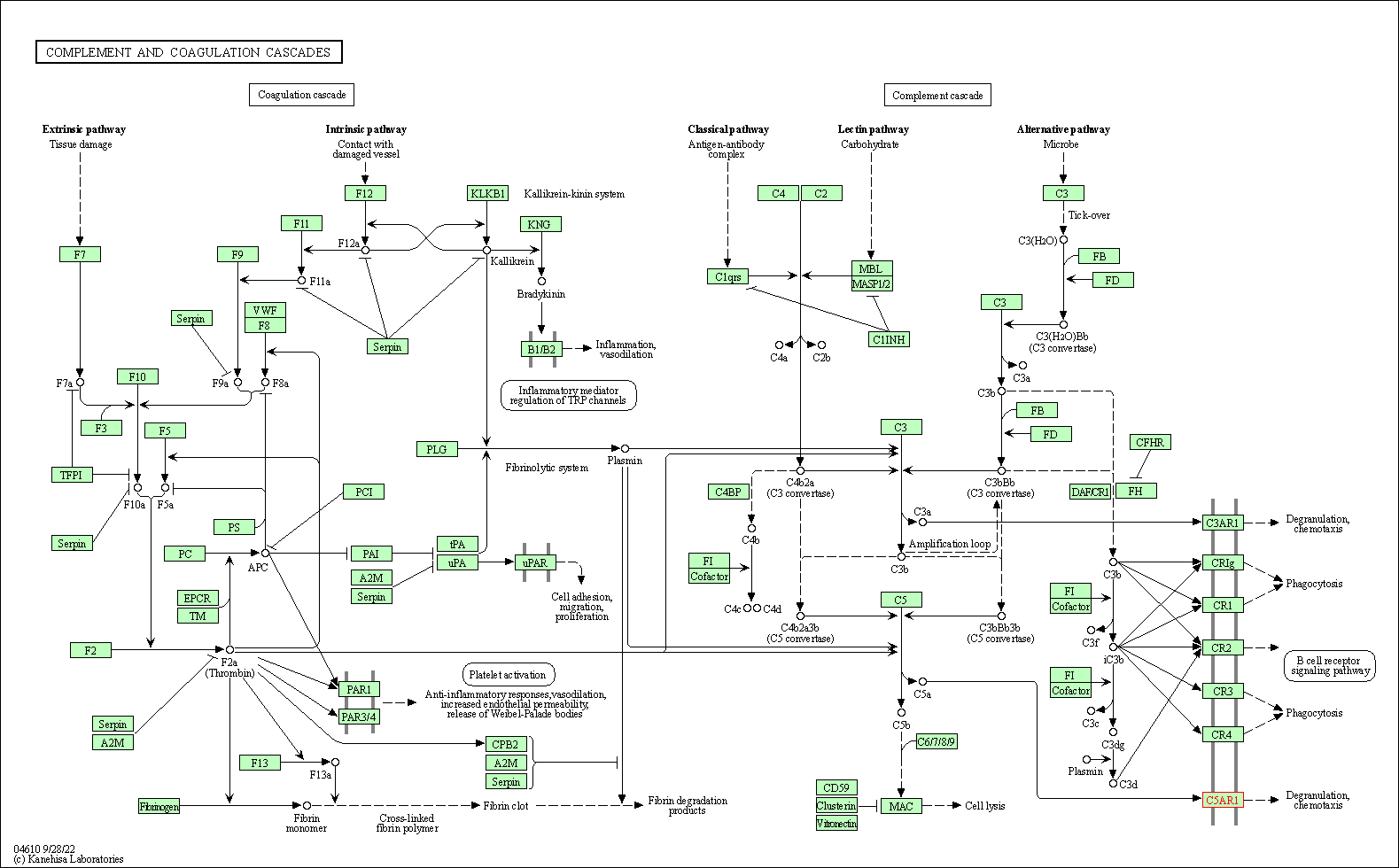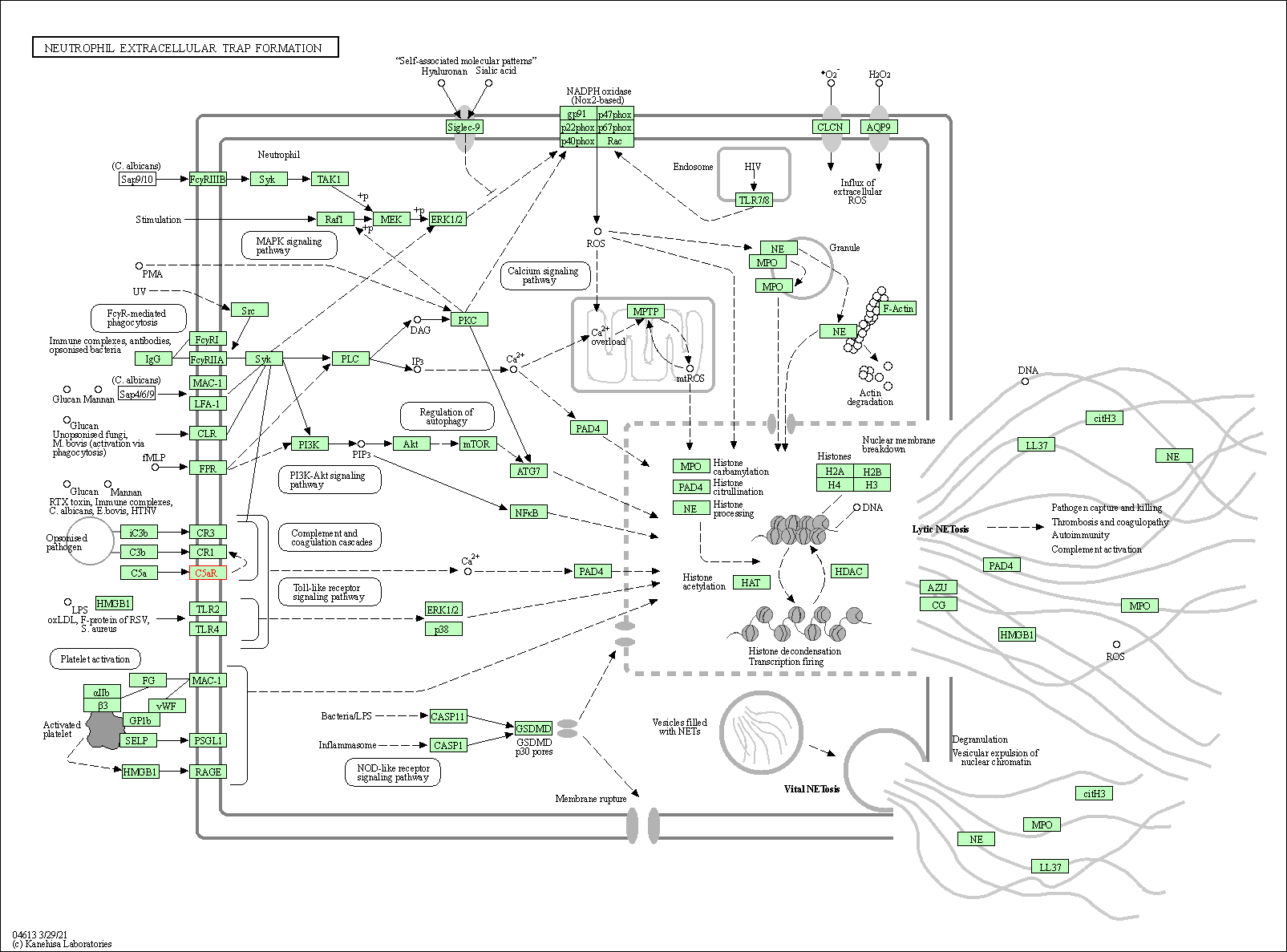Target Information
| Target General Information | Top | |||||
|---|---|---|---|---|---|---|
| Target ID |
T94912
|
|||||
| Target Name |
HUMAN C5a receptor (C5aR)
|
|||||
| Synonyms |
CD88; C5aR; C5a-R; C5a anaphylatoxin chemotactic receptor 1; C5R1
Click to Show/Hide
|
|||||
| Gene Name |
C5AR1
|
|||||
| Disease | [+] 1 Target-related Diseases | + | ||||
| 1 | COVID-19 [ICD-11: 1D6Y] | |||||
| Function |
The ligand interacts with at least two sites on the receptor: a high-affinity site on the extracellular N-terminus, and a second site in the transmembrane region which activates downstream signaling events. Receptor activation stimulates chemotaxis, granule enzyme release, intracellular calcium release and superoxide anion production. Receptor for the chemotactic and inflammatory peptide anaphylatoxin C5a.
Click to Show/Hide
|
|||||
| BioChemical Class |
GPCR rhodopsin
|
|||||
| UniProt ID | ||||||
| Sequence |
MDSFNYTTPDYGHYDDKDTLDLNTPVDKTSNTLRVPDILALVIFAVVFLVGVLGNALVVW
VTAFEAKRTINAIWFLNLAVADFLSCLALPILFTSIVQHHHWPFGGAACSILPSLILLNM YASILLLATISADRFLLVFKPIWCQNFRGAGLAWIACAVAWGLALLLTIPSFLYRVVREE YFPPKVLCGVDYSHDKRRERAVAIVRLVLGFLWPLLTLTICYTFILLRTWSRRATRSTKT LKVVVAVVASFFIFWLPYQVTGIMMSFLEPSSPTFLLLKKLDSLCVSFAYINCCINPIIY VVAGQGFQGRLRKSLPSLLRNVLTEESVVRESKSFTRSTVDTMAQKTQAV Click to Show/Hide
|
|||||
| 3D Structure | Click to Show 3D Structure of This Target | PDB | ||||
| Drugs and Modes of Action | Top | |||||
|---|---|---|---|---|---|---|
| Drugs in Phase 2 Trial | [+] 1 | + | ||||
| 1 | Avdoralimab | Drug Info | Phase 2 | Coronavirus Disease 2019 (COVID-19) | [2] | |
| Mode of Action | [+] 1 Modes of Action | + | ||||
| Inhibitor | [+] 1 Inhibitor drugs | + | ||||
| 1 | Avdoralimab | Drug Info | [1], [3] | |||
| Cell-based Target Expression Variations | Top | |||||
|---|---|---|---|---|---|---|
| Cell-based Target Expression Variations | ||||||
| Drug Binding Sites of Target | Top | |||||
|---|---|---|---|---|---|---|
| Ligand Name: Oleic acid | Ligand Info | |||||
| Structure Description | Crystal structure of thermostabilised human C5a anaphylatoxin chemotactic receptor 1 (C5aR) in complex with NDT9513727 | PDB:5O9H | ||||
| Method | X-ray diffraction | Resolution | 2.70 Å | Mutation | Yes | [4] |
| PDB Sequence |
NTLRVPDILA
40 LVIFAVVFLV50 GVLGNALVVW60 VTAFEAKRTI70 NAIWFLNLAV80 ADFLACLALP 90 ALFTSIVQHH100 HWPFGGAACS110 ILPSLILLNM120 YASILLLATI130 SADRFLLVFK 140 PAWCQRFRGA150 GLAWILCAVA160 WGLALLLTIP170 SALYRVVREE180 YFPPKVLCGV 190 DHDKRRERAV202 AIVRLVLGFL212 WPLLTLTICY222 TFILLRTWSA232 RETRSTKTLK 242 VVVAVVASFF252 IFWLPYQVTG262 IMMSFLEPSS272 PTFLLLKKLD282 SLCVSFAYIN 292 CCINPIIYVV302 AGQGFQKSLP316 ELLREVLTEE326 SVVR
|
|||||
|
|
ILE38
4.658
LEU41
4.193
VAL42
3.500
ALA45
4.358
VAL46
3.765
ALA63
3.626
ALA66
4.314
LYS67
4.796
ILE70
4.738
TRP74
3.802
LEU76
4.650
VAL80
4.015
LEU84
4.147
PRO90
3.746
PHE93
4.005
THR94
3.669
VAL97
4.120
GLN98
2.343
ALA128
4.330
THR129
4.271
SER131
4.539
ALA132
3.486
ASP133
3.940
PHE135
3.279
LEU136
3.779
PHE139
3.950
LYS140
3.556
TRP143
3.460
PHE147
4.480
ARG148
3.846
GLY149
3.792
GLY151
3.887
LEU152
3.912
ALA153
3.953
TRP154
4.023
ILE155
4.367
LEU156
3.930
ALA158
3.583
VAL159
3.923
GLY162
3.423
LEU163
3.950
LEU166
4.739
ALA201
4.089
ILE204
3.987
VAL205
4.667
LEU207
3.867
VAL208
4.605
PHE211
4.253
LEU212
3.880
TRP213
4.649
LEU215
3.988
LEU216
3.423
THR217
3.864
LEU218
3.435
THR219
3.831
ILE220
3.488
CYS221
4.012
TYR222
4.012
THR223
3.617
PHE224
3.242
LEU226
3.681
LEU227
3.695
ARG228
3.659
THR229
4.915
TRP230
3.149
SER231
3.389
LYS242
3.413
VAL245
3.672
ALA246
3.727
VAL248
4.010
ALA249
3.905
SER250
3.800
PHE252
3.688
ILE253
3.416
PHE254
4.112
LEU256
4.490
VAL260
3.870
ILE263
4.087
MET264
3.929
ILE291
3.907
CYS294
4.301
ILE295
3.550
ILE298
4.072
ILE299
3.988
VAL302
3.817
ALA303
4.363
|
|||||
| Ligand Name: n,n-Bis(1,3-benzodioxol-5-ylmethyl)-1-butyl-2,4-diphenyl-1h-imidazole-5-methanamine | Ligand Info | |||||
| Structure Description | Crystal structure of thermostabilised human C5a anaphylatoxin chemotactic receptor 1 (C5aR) in complex with NDT9513727 | PDB:5O9H | ||||
| Method | X-ray diffraction | Resolution | 2.70 Å | Mutation | Yes | [4] |
| PDB Sequence |
NTLRVPDILA
40 LVIFAVVFLV50 GVLGNALVVW60 VTAFEAKRTI70 NAIWFLNLAV80 ADFLACLALP 90 ALFTSIVQHH100 HWPFGGAACS110 ILPSLILLNM120 YASILLLATI130 SADRFLLVFK 140 PAWCQRFRGA150 GLAWILCAVA160 WGLALLLTIP170 SALYRVVREE180 YFPPKVLCGV 190 DHDKRRERAV202 AIVRLVLGFL212 WPLLTLTICY222 TFILLRTWSA232 RETRSTKTLK 242 VVVAVVASFF252 IFWLPYQVTG262 IMMSFLEPSS272 PTFLLLKKLD282 SLCVSFAYIN 292 CCINPIIYVV302 AGQGFQKSLP316 ELLREVLTEE326 SVVR
|
|||||
|
|
||||||
| Click to View More Binding Site Information of This Target with Different Ligands | ||||||
| Different Human System Profiles of Target | Top |
|---|---|
|
Human Similarity Proteins
of target is determined by comparing the sequence similarity of all human proteins with the target based on BLAST. The similarity proteins for a target are defined as the proteins with E-value < 0.005 and outside the protein families of the target.
A target that has fewer human similarity proteins outside its family is commonly regarded to possess a greater capacity to avoid undesired interactions and thus increase the possibility of finding successful drugs
(Brief Bioinform, 21: 649-662, 2020).
Human Tissue Distribution
of target is determined from a proteomics study that quantified more than 12,000 genes across 32 normal human tissues. Tissue Specificity (TS) score was used to define the enrichment of target across tissues.
The distribution of targets among different tissues or organs need to be taken into consideration when assessing the target druggability, as it is generally accepted that the wider the target distribution, the greater the concern over potential adverse effects
(Nat Rev Drug Discov, 20: 64-81, 2021).
Human Pathway Affiliation
of target is determined by the life-essential pathways provided on KEGG database. The target-affiliated pathways were defined based on the following two criteria (a) the pathways of the studied target should be life-essential for both healthy individuals and patients, and (b) the studied target should occupy an upstream position in the pathways and therefore had the ability to regulate biological function.
Targets involved in a fewer pathways have greater likelihood to be successfully developed, while those associated with more human pathways increase the chance of undesirable interferences with other human processes
(Pharmacol Rev, 58: 259-279, 2006).
Biological Network Descriptors
of target is determined based on a human protein-protein interactions (PPI) network consisting of 9,309 proteins and 52,713 PPIs, which were with a high confidence score of ≥ 0.95 collected from STRING database.
The network properties of targets based on protein-protein interactions (PPIs) have been widely adopted for the assessment of target’s druggability. Proteins with high node degree tend to have a high impact on network function through multiple interactions, while proteins with high betweenness centrality are regarded to be central for communication in interaction networks and regulate the flow of signaling information
(Front Pharmacol, 9, 1245, 2018;
Curr Opin Struct Biol. 44:134-142, 2017).
Human Similarity Proteins
Human Tissue Distribution
Human Pathway Affiliation
Biological Network Descriptors
|
|
|
Note:
If a protein has TS (tissue specficity) scores at least in one tissue >= 2.5, this protein is called tissue-enriched (including tissue-enriched-but-not-specific and tissue-specific). In the plots, the vertical lines are at thresholds 2.5 and 4.
|
| KEGG Pathway | Pathway ID | Affiliated Target | Pathway Map |
|---|---|---|---|
| Neuroactive ligand-receptor interaction | hsa04080 | Affiliated Target |

|
| Class: Environmental Information Processing => Signaling molecules and interaction | Pathway Hierarchy | ||
| Complement and coagulation cascades | hsa04610 | Affiliated Target |

|
| Class: Organismal Systems => Immune system | Pathway Hierarchy | ||
| Neutrophil extracellular trap formation | hsa04613 | Affiliated Target |

|
| Class: Organismal Systems => Immune system | Pathway Hierarchy | ||
| Degree | 3 | Degree centrality | 3.22E-04 | Betweenness centrality | 7.33E-04 |
|---|---|---|---|---|---|
| Closeness centrality | 2.02E-01 | Radiality | 1.35E+01 | Clustering coefficient | 0.00E+00 |
| Neighborhood connectivity | 5.33E+01 | Topological coefficient | 3.33E-01 | Eccentricity | 13 |
| Download | Click to Download the Full PPI Network of This Target | ||||
| Chemical Structure based Activity Landscape of Target | Top |
|---|---|
| Target Poor or Non Binders | Top | |||||
|---|---|---|---|---|---|---|
| Target Poor or Non Binders | ||||||
| References | Top | |||||
|---|---|---|---|---|---|---|
| REF 1 | Blockade of the C5a-C5aR axis alleviates lung damage in hDPP4-transgenic mice infected with MERS-CoV. Emerg Microbes Infect. 2018 Apr 24;7(1):77. | |||||
| REF 2 | ClinicalTrials.gov (NCT04371367) Avdoralimab an Anti-C5aR Antibody, in Patients With COVID-19 Severe Pneumonia ( FORCE ). U.S. National Institutes of Health. | |||||
| REF 3 | Complement as a target in COVID-19 Nat Rev Immunol. 2020 Apr 23. | |||||
| REF 4 | Structure of the complement C5a receptor bound to the extra-helical antagonist NDT9513727. Nature. 2018 Jan 3;553(7686):111-114. | |||||
If You Find Any Error in Data or Bug in Web Service, Please Kindly Report It to Dr. Zhou and Dr. Zhang.

